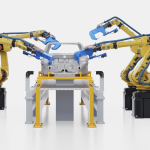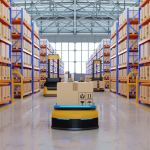As we look toward the next phase of manufacturing innovation, it’s clear that 3D scanning and artificial intelligence (AI) are not just tools—they’re catalysts for transformative change. These technologies, when combined, promise to redefine how we approach efficiency, product design, and operational resilience. The potential here isn’t incremental; it’s revolutionary.
The challenge for operations leaders in manufacturing is not whether to adopt these technologies, but how to strategically integrate them to drive measurable outcomes. The manufacturers who get this right will lead the way, turning technology into a competitive advantage and reshaping their industries in the process.
Redefining Precision with AI and 3D Scanning
The precision of 3D scanning has always been one of its greatest strengths, but its real power is unlocked when combined with AI. Together, these technologies streamline data collection and processing, turning what was once a time-consuming and resource-intensive process into an agile and efficient workflow.
Processing large datasets from 3D scans has historically required significant computing power and storage. Now, with AI-driven algorithms, we can filter out noise, refine results, and accelerate workflows without compromising quality. This means not only faster results but also significant reductions in the storage requirements that come with cloud-based processing.
For manufacturing operations, this translates into more efficient product development cycles, fewer bottlenecks, and the ability to allocate resources to strategic priorities instead of labor-intensive refinement processes.
Making Photogrammetry Accessible
One of the most exciting developments in this space is the evolution of photogrammetry, the process of using overlapping images to create 3D models. Historically, this required significant time and expertise, but with AI, the process is becoming far more accessible.
Instead of capturing thousands of photos, we can now use video footage or even a handful of images from a smartphone to create accurate 3D models. This accessibility democratizes the technology, making it viable for smaller manufacturers and teams without extensive resources.
The ability to combine photogrammetry with 3D scanning further enhances its utility. For example, a precise 3D scanner can capture an object’s intricate details, while AI-powered photogrammetry recreates the surrounding environment, offering a comprehensive digital twin. This hybrid approach opens up endless possibilities for modeling complex production environments or testing new layouts without disrupting operations.
Driving Innovation in Healthcare
One area where 3D scanning and AI are already making a profound impact is healthcare manufacturing. Personalized medical devices such as prosthetics, implants, and medical corsets rely heavily on these technologies to improve patient outcomes. The ability to tailor products to individual needs not only enhances performance but also opens the door to significant humanitarian impact.
While pricing has historically been a barrier to wider adoption, AI is driving costs down by simplifying processes and making advanced 3D scanning technologies more accessible. As these barriers diminish, the potential for patient-specific solutions will grow exponentially. This isn’t just about improving healthcare products—it’s about creating opportunities for innovation that serve both patients and the broader industry.
Preparing the Next Generation
It’s not just about what these technologies can do today—it’s about the future they enable. Introducing 3D scanning and AI into educational environments can equip the next generation of engineers and operations leaders with the tools they need to drive tomorrow’s innovations.
Imagine students exploring additive manufacturing, creating digital twins, or experimenting with product design using 3D scanning and AI. This early exposure will spark creativity, build essential skills, and prepare the workforce of the future to tackle the challenges of an increasingly complex manufacturing landscape.
Leading Through Innovation
The manufacturing industry stands on the brink of a new era. 3D scanning and AI are no longer niche tools—they are central to the way we will work, design, and compete in 2025 and beyond.
For operations leaders, the choice is clear: integrate these technologies strategically or risk being left behind. The opportunities are vast, from streamlining workflows and creating digital twins to enabling personalized products and uncovering new market opportunities.
The future of manufacturing isn’t a distant concept—it’s here. And it’s being built by those of us willing to embrace innovation, take bold steps, and lead the way toward a smarter, more resilient industry.







